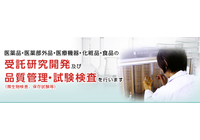飲食店舗の巡回衛生検査
飲食店、食品工場、スーパー、喫茶店、ホテル厨房、ゴルフ場厨房等を毎月定期的に訪問し、製造所内の設備のふき取り試験を行います。
飲食店、食品店、食品工場、スーパーバックヤード、喫茶店、ホテル厨房、ゴルフ場厨房、葬儀式場厨房等を毎月定期的に訪問し、製造所内の設備をふき取り綿棒でふき取り試験を行います。 検出されるコロニーから微生物汚染度を判定し、一覧表にしてご報告いたします。 通常の検査では、一般生菌数(菌汚染の指標)、大腸菌群(土埃等による環境汚染の指標)、大腸菌(糞便系の汚れ)、黄色ブドウ球菌(調理者の手指の傷等が原因)を1セットとして試験を行います。ご希望によりサルモネラ(食肉の菌汚染)、腸炎ビブリオ(魚肉の菌汚染)、カンピロバクター(鶏肉の菌汚染)等を追加することも可能です。 通常5か所のふき取り検査及び1検体の食材の抜き取り検査を行い、同時に目視による衛生状態の確認及び指摘を行います。結果表は採点表を作成し、年間を通じての変動等が一目でわかるようにご報告いたします。(食品衛生法・HACCP対応)
基本情報
飲食店、食品店、食品工場、スーパーバックヤード、喫茶店、ホテル厨房、ゴルフ場厨房、葬儀式場厨房等を毎月定期的に訪問し、製造所内の設備をふき取り綿棒でふき取り試験を行います。 検出されるコロニーから微生物汚染度を判定し、一覧表にしてご報告いたします。
価格帯
納期
用途/実績例
通常の検査では、一般生菌数(菌汚染の指標)、大腸菌群(土埃等による環境汚染の指標)、大腸菌(糞便系の汚れ)、黄色ブドウ球菌(調理者の手指の傷等が原因)を1セットとして試験を行います。ご希望によりサルモネラ(食肉の菌汚染)、腸炎ビブリオ(魚肉の菌汚染)、カンピロバクター(鶏肉の菌汚染)等を追加することも可能です。 通常5か所のふき取り検査及び1検体の食材の抜き取り検査を行い、同時に目視による衛生状態の確認及び指摘を行います。結果表は採点表を作成し、年間を通じての変動等が一目でわかるようにご報告いたします。(食品衛生法・HACCP対応)
カタログ(1)
カタログをまとめてダウンロードおすすめ製品
取り扱い会社
1996年に創業以来、生化学関連の受託研究開発を中心にした活動を行っています。 受託研究開発;生化学に関連した研究開発(製品の開発、製品の効能効果の判定)、発酵、消臭関連製品の開発 微生物検査;食品工場、化粧品工場の衛生検査、 自社プロジェクトとして、筋ジストロフィー症の検査薬、治療薬の開発を行っています。




















